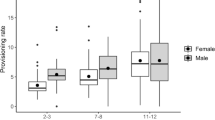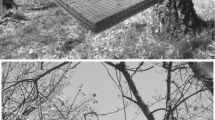Abstract
Male paternity assurance behaviour during the female fertile period has been widely documented amongst birds. In contrast, how sex-specific behavioural strategies vary with local breeding synchrony levels remains largely unknown. This is important because, in many species, intra-population patterns of extra-pair fertilisation rates, and hence cuckoldry risk, are known to vary with the number of simultaneously fertile females. Each sex may therefore differ in how they behave towards male conspecifics during different degrees of breeding synchrony. Here I provide evidence of such sex-specific differences in the golden whistler (Pachycephala pectoralis), a species in which within-pair paternity assurance is negatively associated with breeding synchrony. Via simulated territorial intrusions using decoy males, I show that males, but not females, increase levels of aggression to male intruders during periods of low synchrony, possibly because cuckoldry risk is greatest during this period. In addition, males appear to invest more effort into mate guarding after, but not before, territorial intrusions during this period. These inter-sexual differences may reflect conflicts in interest between the sexes, with females consistently showing interest in males during the fertile period regardless of synchrony levels and males investing more resources into expelling intruders when the risk of paternity loss is greatest. This study thus provides evidence that males may be able to detect variation in breeding synchrony and cuckoldry risk and adjust their paternity assurance behaviour accordingly.


Similar content being viewed by others
References
Arlt D, Hansson B, Bensch S, von Schantz T, Hasselquist D (2004) Breeding synchrony does not affect extra-pair paternity in great reed warblers. Behaviour 141:863–880
Ballentine B, Badyaev AV, Hill GE (2003) Changes in song complexity correspond to periods of female fertility in blue grosbeaks (Guiraca caerulea). Ethology 109:55–66
Birkhead TR, Møller AP (1992) Sperm competition in birds: evolutionary causes and consequences. Academic, London
Brylawski AMZ, Whittingham LA (2004) An experimental study of mate guarding and paternity in house wrens. Anim Behav 68:1417–1424
Chelen AAR, Garcia CM, Riebel K (2005) Variation in the song of a sub-oscine, the vermilion flycatcher. Behaviour 142:1115–1132
Chuang-Dobbs HC, Webster MS, Holmes RT (2001a) The effectiveness of mate guarding by male black-throated blue warblers. Behav Ecol 12:541–546
Chuang-Dobbs HC, Webster MS, Holmes RT (2001b) Paternity and parental care in the black-throated blue warbler, Dendroica caerulescens. Anim Behav 62:83–92
Conrad KF, Robertson RJ, Boag PT (1998) Frequency of extrapair young increases in second broods of Eastern phoebes. Auk 115:497–502
Emlen ST, Oring LW (1977) Ecology, sexual selection, and the evolution of mating systems. Science 197:215–223
Fishman MA, Stone L (2005) Fertility assurance and breeding synchrony. Bull Math Biol 67:875–883
Fishman MA, Stone L (2006) Trade up polygyny and breeding synchrony in avian populations. J Theor Biol 238:104–110
Johnsen A, Lifjeld JT (2003) Ecological constraints on extra-pair paternity in the bluethroat. Oecologia 136:476–483
Kempenaers B, Verheyen GR, Dhondt AA (1995) Mate guarding and copulation behaviour in monogamous and polygynous blue tits: do males follow a best-of-a-bad-job strategy? Behav Ecol Sociobiol 36:33–42
Kraaijeveld K, Carew PJ, Billing T, Adcock GJ, Mulder RA (2004) Extra-pair paternity does not result in differential sexual selection in the mutually ornamented black swan (Cygnus atratus). Mol Ecol 13:1625–1633
Lindstedt ER, Oh KP, Badyaev AV (2007) Ecological, social, and genetic contingency of extrapair behavior in a socially monogamous bird. J Avian Biol 38:214–223
Marthinsen G, Kleven O, Brenna E, Lifjeld JT (2005) Part-time mate guarding affects paternity in male reed buntings (Emberiza schoeniclus). Ethology 111:397–409
Møller AP (1991) Why mated songbirds sing so much: mate guarding and male announcement of mate fertility status. Am Nat 138:994–1014
Rios-Chelen AA, Garcia CM (2007) Responses of a sub-oscine bird during playback: effects of different song variants and breeding period. Behav Process 74:319–325
Saino N, Primmer CR, Ellegren H, Møller AP (1997) An experimental study of paternity and tail ornamentation in the barn swallow (Hirundo rustica). Evolution 51:562–570
Schwagmeyer PL, Ketterson ED (1999) Breeding synchrony and EPF rates: the key to a can of worms? Trends Ecol Evol 14:47–48
Shuster SM, Wade MJ (2003) Mating systems and strategies. Princeton University Press, Princeton
Stewart IRK, Hanschu RD, Burke T, Westneat DF (2006) Tests of ecological, phenotypic, and genetic correlates of extra-pair paternity in the house sparrow. Condor 108:399–413
Strohbach S, Curio E, Bathen A, Epplen JT, Lubjuhn T (1998) Extrapair paternity in the great tit (Parus major): a test of the “good genes” hypothesis. Behav Ecol 9:388–396
Stutchbury BJM (1998) Female mate choice of extra-pair males: breeding synchrony is important. Behav Ecol Sociobiol 43:213–215
Stutchbury BJ, Morton ES (1995) The effect of breeding synchrony on extra-pair mating systems in songbirds. Behaviour 132:675–690
Stutchbury BJM, Piper WH, Neudorf DL, Tarof SA, Rhymer JM, Fuller G, Fleischer RC (1997) Correlates of extra-pair fertilization success in hooded warblers. Behav Ecol Sociobiol 40:119–126
Stutchbury BJM, Morton ES, Piper WH (1998) Extra-pair mating system of a synchronously breeding tropical songbird. J Avian Biol 29:72–78
van de Crommenacker J, Richardson DS, Groothuis TGG, Eising CM, Dekker AL, Komdeur J (2004) Testosterone, cuckoldry risk and extra-pair opportunities in the Seychelles warbler. Proc R Soc Lond B Biol Sci 271:1023–1031
van Dongen WFD (2006) Variation in singing behaviour reveals possible functions of song in male golden whistlers. Behaviour 143:57–82
van Dongen WFD, Mulder RA (2008) Male and female golden whistlers respond differently to static and dynamic signals of male intruders. Behav Ecol (in press)
van Dongen WFD, Yocom LL (2005) Breeding biology of a migratory Australian passerine, the golden whistler (Pachycephala pectoralis). Aust J Zool 53:213–220
Westneat DF (1990) Genetic parentage in the indigo bunting: a study using DNA fingerprinting. Behav Ecol Sociobiol 27:67–76
Westneat DF, Gray EM (1998) Breeding synchrony and extrapair fertilizations in two populations of red-winged blackbirds. Behav Ecol 9:456–464
Westneat DF, Stewart IRK (2003) Extra-pair paternity in birds: causes, correlates, and conflict. Ann Rev Ecol Evol Syst 34:365–396
Westneat DF, Mays HL (2005) Tests of spatial and temporal factors influencing extra-pair paternity in red-winged blackbirds. Mol Ecol 14:2155–2167
Westneat DF, Sherman PW, Morton ML (1990) The ecology and evolution of extra-pair copulations in birds. In: Power DM (ed) Current ornithology. Plenum, New York, pp 331–370
Acknowledgments
I am very grateful to Raoul Mulder for much advice and support throughout this study, to Larissa Yocom and Grainne Maguire for their assistance with field work, to Brian Elbers and Kees Müller for providing cages to house the captive whistlers and to Ken Kraaijeveld and two anonymous referees for useful comments on earlier versions of the manuscript. This research was funded by the Holsworth Wildlife Research Fund, the Loftus-Hills Memorial Fund and the Stuart Leslie Bird Research Award. Experiments were conducted under permits issued by the University of Melbourne Animal Experimentation and Ethics Register (permit number 01011), the Department of Sustainability and Environment, Australia (research permit number 10001145) and Australian Bird and Bat Banding Scheme (authority number 1405).
Author information
Authors and Affiliations
Corresponding author
Rights and permissions
About this article
Cite this article
van Dongen, W.F.D. Mate guarding and territorial aggression vary with breeding synchrony in golden whistlers (Pachycephala pectoralis). Naturwissenschaften 95, 537–545 (2008). https://doi.org/10.1007/s00114-008-0356-1
Received:
Revised:
Accepted:
Published:
Issue Date:
DOI: https://doi.org/10.1007/s00114-008-0356-1




